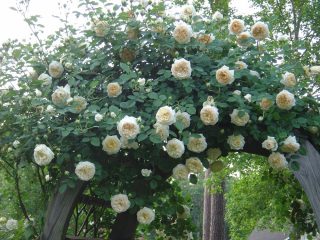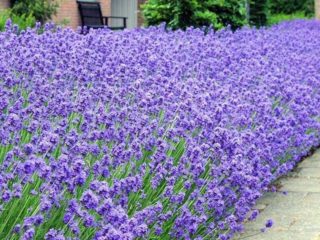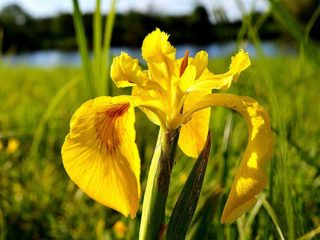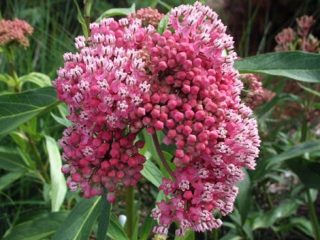Content
Evening primrose Missouri (lat. Oenothera missouriensis) is a perennial herbaceous plant that is characterized by lush flowering in the evening. Therefore, the culture is also called the night star. The plant belongs to the numerous genus Oslinnik and is a representative of the Fireweed family. In the wild, the Missouri evening primrose is found in south-central North America. The plant has been cultivated since 1811 and is valued for its high decorativeness and unpretentiousness.
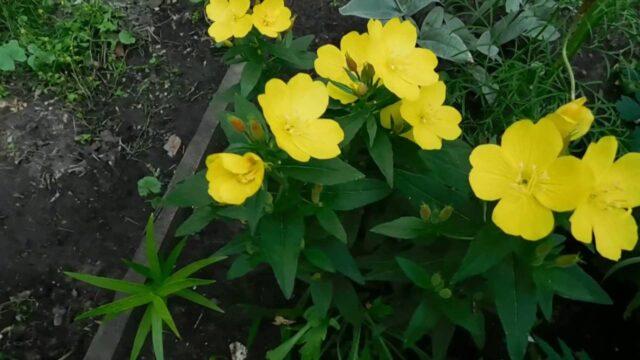
Evening primrose Missouri has gained wide popularity as an element of landscape design.
Description of evening primrose Missouri
This perennial is a low-growing herbaceous shrub. Its stems rise above the soil. Their length reaches 35-40 cm. The shoots are rigidly pubescent. The leaves on them are arranged alternately. The plates are dense, narrow-lanceolate or oval with a solid edge. Their length reaches 10 cm, and their width is 3-4 cm. The leaves have a smooth surface and a dark green color.Light veins are clearly visible on them.
The perennial Missouri evening primrose, unlike other types of crops, has large flowers with a diameter of about 10 cm. They consist of five round golden-yellow petals, which interlock with each other and are cup-shaped. On the eve of dusk, the buds open in a matter of seconds.
The lifespan of each flower is only one day. In rainy and cloudy weather, the buds remain open all day, and in sunny weather - until noon. Evening primrose Missouri blooms in July and continues for two months if conditions are favorable. The buds of this species are single; they appear from the axils of the leaves at the tops of the shoots. When opened, the flowers almost completely hide the green leaves. After pollination, capsule fruits appear on the plant, inside of which there are small dust-like seeds. They remain viable for up to three years.
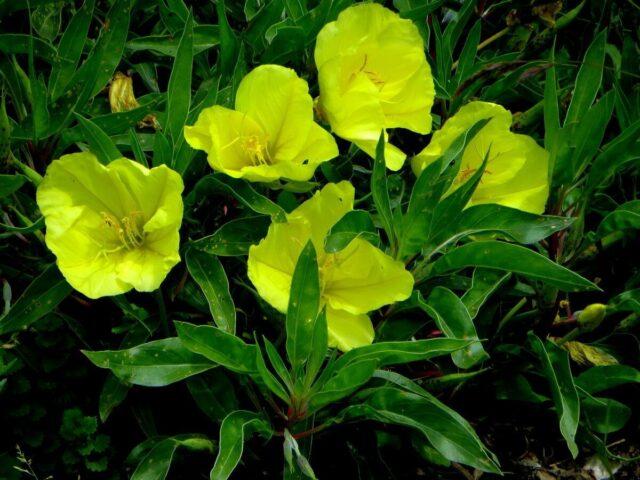
Evening primrose flowers exude a pleasant citrus aroma.
Planting evening primrose seeds in open ground
It is recommended to use seeds for planting evening primrose. In order for them to germinate successfully and be able to fully develop, it is necessary to carry out the procedure correctly, taking into account the requirements of the culture.
Selection and preparation of a site
For Missouri evening primrose, you need to choose a sunny, open place, protected from cold gusts of wind. The best option may be the southern or southwestern side of the site. When choosing a location, you need to take into account that the perennial does not tolerate waterlogging of the soil, therefore, during thaws and rains, water should not stagnate on it.
Evening primrose Missouri is undemanding to soil composition. The main thing is that the soil is loose and has good moisture and air permeability.The plant prefers a neutral acidity level.
At least two weeks before planting, the site must be dug up and the roots of perennial weeds removed. At the same time, it is recommended to add 5 kg of humus to the soil for each square. m.
Sowing seeds
It is recommended to plant Missouri evening primrose seeds in the spring, when the soil has warmed up sufficiently and the threat of return frosts has passed. To do this, you need to prepare furrows 1 cm deep, maintaining a distance between rows of 10-15 cm.
Before sowing, the seeds must be mixed with sand, which promotes uniform distribution. After planting, cover with sand and level the surface, and then water the area using sprinkling.
Growing evening primrose seedlings from seeds
To get strong perennial seedlings by the beginning of the season, it is recommended to pre-grow seedlings at home. To do this, you will need to prepare wide containers about 10-12 cm high. They need to be filled with a nutritious soil mixture consisting of turf, sand and peat in equal volumes. Two days before planting, the substrate must be watered with a solution of potassium permanganate and slightly dried until characteristic flowability appears.
It is recommended to plant seeds to a depth of 0.5 cm in a moistened substrate. After this, cover the container with glass or film and move it to a dark place with a temperature of +20-22 °C. If all conditions are met, seedlings appear in 2-3 weeks. After this, the container needs to be moved to a light windowsill.
Caring for Missouri evening primrose seedlings involves performing standard measures.The seedlings need to be watered in doses as the top layer of soil dries. It is also recommended to ventilate the seedlings daily. And when the seedlings get stronger, they need to be adapted to external conditions and the cover must be completely removed.
At the stage of 2-3 true leaves, it is recommended to plant Missouri evening primrose seedlings into separate cups. And ten days after that, feed with complex mineral fertilizer intended for seedlings. The optimal maintenance regime during this period is +18-20 °C.

Perennial seedlings bloom in the year of planting
Planting seedlings in open ground
You can plant Missouri evening primrose seedlings in open ground at the end of May, at the beginning of June. Because by this time stable warm weather has already established itself.
For planting, you need to prepare holes 10 cm deep at a distance of 25-30 cm from each other. This will allow plants to fully develop and not compete for moisture and nutrition. When planting, seedlings should not be buried. At the end of the procedure, water the plants generously and cover the area with agrofibre for 2-3 days, which will speed up the adaptation of the seedlings.
Evening Primrose Missourian Care
The perennial does not require complex care and even a novice gardener can cope with its cultivation. However, to achieve maximum decorativeness of the Missouri evening primrose, it is recommended to follow simple rules of agricultural technology.
Watering
The crop can withstand short-term drought. But if there is no rain for a long time, it needs regular watering, as it quickly fades. Water can be poured under the root or from above from a watering can. During particularly hot periods, it is recommended to place mulch at the base of the plant to prevent excessive evaporation. To do this, you can use peat or humus.
Fertilizers
It is recommended to feed Missouri evening primrose twice a season. The first time you need to apply fertilizer is at the beginning of the growing season, when the plant grows shoots and leaves. During this period, it is important to use nitroammophoska at the rate of 30 g per bucket of water. The second feeding for perennials is recommended after flowering. At this time, you need to use 40 g of superphosphate and 25 g of potassium sulfide per 10 liters of water. These fertilizers promote the maturation of young shoots and increase the winter hardiness of Missouri evening primrose.
Loosening the soil
The crop reacts poorly to stagnant moisture in the soil. Therefore, throughout the entire growing season it is necessary to regularly loosen the soil at its base. This will provide air access to the roots of the plant.
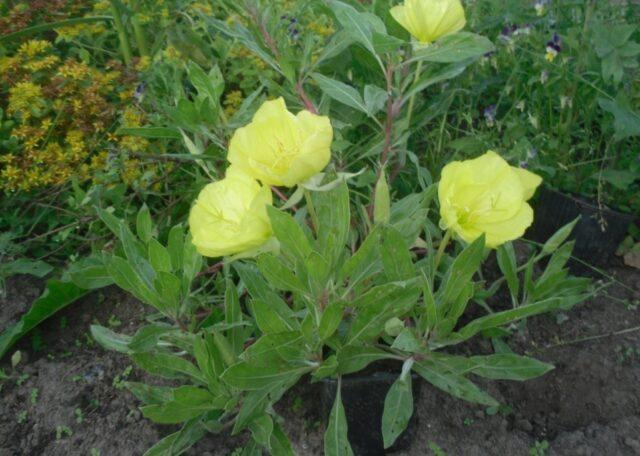
At the initial stage of plant development, it is necessary to regularly remove growing weeds around
Preparing for winter
Before winter, it is recommended to cut off faded and outdated perennial shoots completely. After this, it is necessary to lay a layer of mulch 5-7 cm thick at the base of the plant. And the upper part of the Missouri evening primrose should be covered with agrofibre and spruce branches on top.
Diseases and pests
Evening primrose Missouri has high natural immunity, which makes caring for it much easier. However, when moisture stagnates in the soil, the plant is affected by root rot. In this case, its leaves and shoots sharply lose turgor, but retain their shade. To correct the situation, it is recommended to dig up the perennial, remove the affected root shoots and replant it in a new location. After this, the plant needs to be watered with Previkur Energy.
Among the pests, damage to the Missouri evening primrose can be caused by the larva of the Proserpina hawkmoth. The caterpillar eats the leaves of the plant, thereby weakening it. Therefore, at the first signs of damage, it is recommended to spray the crop with any insecticide.
Reproduction
The perennial must be periodically rejuvenated, which makes it possible to propagate it. In this case, it is necessary to dig up the Missouri evening primrose in the spring and divide it into several parts with pruners. Each of them must have well-developed roots and shoots. After this cutting area, you need to sprinkle it with charcoal and immediately plant the cuttings in a permanent place.
You can also use seeds produced at the end of the season for propagation. To do this, the fruit boxes must be cut in advance and dried on a sunny windowsill, and then used for planting.
Application in landscape design
The unpretentiousness and high decorativeness of the plant were appreciated not only by professional gardeners, but also by amateurs. After all, this plant can be called universal, since the perennial evening primrose can be a tapeworm against the backdrop of a green lawn and combine well with other garden crops.
In landscape design it is suitable for:
- curbs;
- rockeries;
- discounts;
- rock gardens;
- front gardens;
- various flower beds.
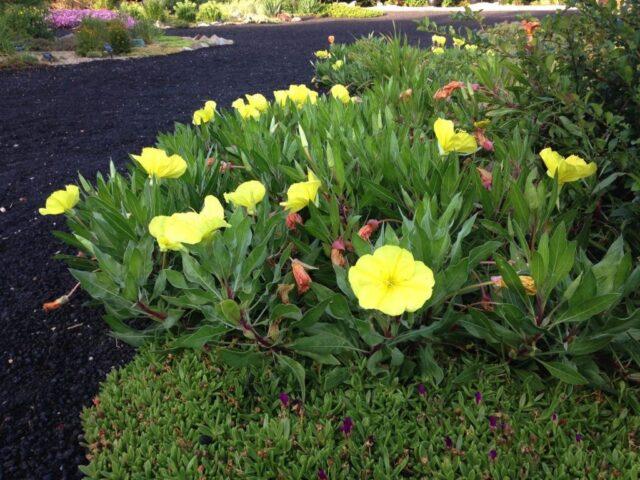
The perennial is able to suppress the development of neighboring crops when planted close together.
Conclusion
Evening primrose Missouri is a unique plant that opens its buds on the eve of dusk. It attracts the eye and creates bright accents in the garden, flowerbed, or garden plot. In addition, the perennial is unpretentious, caring for it does not cause any particular difficulties. But when growing Missouri evening primrose, you need to take into account that it can grow excessively.Therefore, this process must be controlled.
https://youtu.be/THu96qern0A

